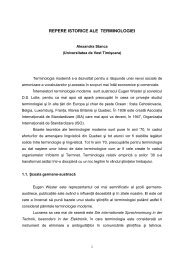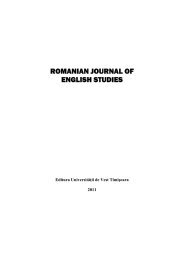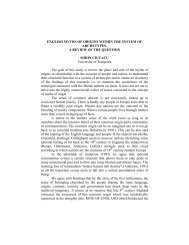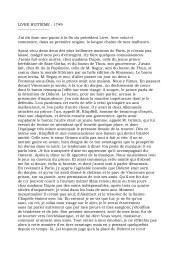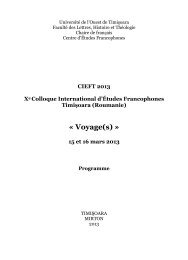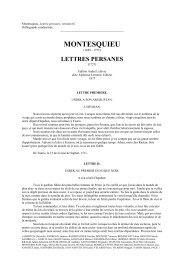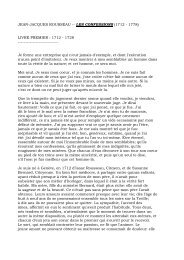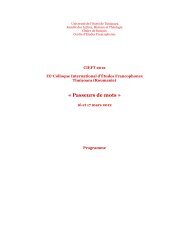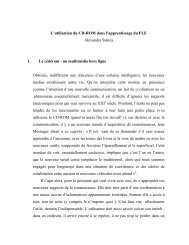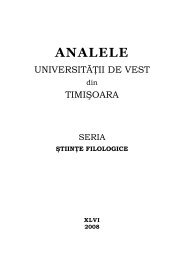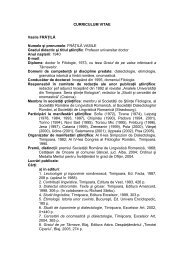TRANSLATION AND MEANING: A CULTURAL- COGNITIVE ...
TRANSLATION AND MEANING: A CULTURAL- COGNITIVE ...
TRANSLATION AND MEANING: A CULTURAL- COGNITIVE ...
You also want an ePaper? Increase the reach of your titles
YUMPU automatically turns print PDFs into web optimized ePapers that Google loves.
4. Bugs Bunny. The name of this character alludes to its generic<br />
membership, physical appearance, as well as its character traits. “Bugs” is<br />
an allusion to “buck teeth”, its projecting upper teeth, but also to “bugging”,<br />
i.e. itsannoying, irritating nature. The other part of the name, “bunny”, on<br />
the other hand, is a hypocoristic form of the generic term. This character is<br />
translated into Serbian as Duško Dugouško (hypocoristic form of a male<br />
name + “long-eared one”), with the original alliteration retained. For the<br />
first part of the name, the translator opted for a relatively common male<br />
name, without the relevant connotative meanings, mainly because of the<br />
sound effect which the combination of the two names achieves: DUŠKO<br />
DUgouŠKO. However, a large part of the meaning conveyed by the original<br />
is lost in the translation. The second part of the translation equivalent,<br />
Dugouško, describes the character’s physical appearance - here, the<br />
adaptation is based on the visual image. It may be interesting to mention<br />
that in the absence of the original imagery, the name Duško Dugouško may<br />
well be applicable to another animal with the same or a similar physical<br />
appearance, e.g. a donkey. (A somewhat more transparent translation<br />
equivalent is the Croatian Zekoslav Mrkva – “rabbit+suffix common for<br />
Slavic male names” + “carrot”, also based on metonymy.) In Hungarian, the<br />
name used for this character is Tapsi Hapsi, where ‘tapsi’ is actually the<br />
short form of the adjective ‘tapsifüles’, i.e. ‘long-eared one’, used<br />
exclusively for characterizing rabbits, and the ‘hapsi’ part means ‘guy,<br />
fellow’. Thus, the translation is yet again based on the visual component<br />
(long, floppy ears), ignoring Bugs Bunny’s character traits. However, unlike<br />
the Serbian equivalent, the name Tapsi Hapsi itself, without the visual<br />
image, makes it clear that its bearer is a rabbit. The German equivalent is,<br />
unfortunately, just Bugs Bunny.<br />
5. Wimpy. The original name suggests a person who is not strong,<br />
brave or confident. In its equivalent in Serbian, Pera Ždera ('Pera', the<br />
hypocoristic form for Petar + ‘Ždera’ – a term of endearment for a<br />
gluttonous person), on the other hand, the focus is on the auditory effect<br />
(rhyme), and the visual component (Wimpy's stout appearance) served as a<br />
criterion for the adaptation, i.e. for the translator's choice of ‘Ždera’. The<br />
Serbian translation equivalent covers only a small part of the original name,<br />
because it focuses on just one of the character’s features and once again the<br />
decisive criterion in transposing the name was the rhyming of its two parts.<br />
All of Wimpy’s other traits – inconsistency, weepiness, inefficiency,<br />
contained in the original name, are only revealed on watching the cartoon.<br />
In Hungary, the cartoon Popeye, the Sailor is not well-known, hence the<br />
authors have not been able to find its equivalent in this language. The<br />
German translator decided to leave the name in the original – Wimpy.



